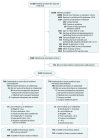Effect of Fresh vs Standard-issue Red Blood Cell Transfusions on Multiple Organ Dysfunction Syndrome in Critically Ill Pediatric Patients: A Randomized Clinical Trial
- PMID: 31821429
- PMCID: PMC7081749
- DOI: 10.1001/jama.2019.17478
Effect of Fresh vs Standard-issue Red Blood Cell Transfusions on Multiple Organ Dysfunction Syndrome in Critically Ill Pediatric Patients: A Randomized Clinical Trial
Abstract
Importance: The clinical consequences of red blood cell storage age for critically ill pediatric patients have not been examined in a large, randomized clinical trial.
Objective: To determine if the transfusion of fresh red blood cells (stored ≤7 days) reduced new or progressive multiple organ dysfunction syndrome compared with the use of standard-issue red blood cells in critically ill children.
Design, setting, and participants: The Age of Transfused Blood in Critically-Ill Children trial was an international, multicenter, blinded, randomized clinical trial, performed between February 2014 and November 2018 in 50 tertiary care centers. Pediatric patients between the ages of 3 days and 16 years were eligible if the first red blood cell transfusion was administered within 7 days of intensive care unit admission. A total of 15 568 patients were screened, and 13 308 were excluded.
Interventions: Patients were randomized to receive either fresh or standard-issue red blood cells. A total of 1538 patients were randomized with 768 patients in the fresh red blood cell group and 770 in the standard-issue group.
Main outcomes and measures: The primary outcome measure was new or progressive multiple organ dysfunction syndrome, measured for 28 days or to discharge or death.
Results: Among 1538 patients who were randomized, 1461 patients (95%) were included in the primary analysis (median age, 1.8 years; 47.3% girls), in which there were 728 patients randomized to the fresh red blood cell group and 733 to the standard-issue group. The median storage duration was 5 days (interquartile range [IQR], 4-6 days) in the fresh group vs 18 days (IQR, 12-25 days) in the standard-issue group (P < .001). There were no significant differences in new or progressive multiple organ dysfunction syndrome between fresh (147 of 728 [20.2%]) and standard-issue red blood cell groups (133 of 732 [18.2%]), with an unadjusted absolute risk difference of 2.0% (95% CI, -2.0% to 6.1%; P = .33). The prevalence of sepsis was 25.8% (160 of 619) in the fresh group and 25.3% (154 of 608) in the standard-issue group. The prevalence of acute respiratory distress syndrome was 6.6% (41 of 619) in the fresh group and 4.8% (29 of 608) in the standard-issue group. Intensive care unit mortality was 4.5% (33 of 728) in the fresh group vs 3.5 % (26 of 732) in the standard-issue group (P = .34).
Conclusions and relevance: Among critically ill pediatric patients, the use of fresh red blood cells did not reduce the incidence of new or progressive multiple organ dysfunction syndrome (including mortality) compared with standard-issue red blood cells.
Trial registration: ClinicalTrials.gov Identifier: NCT01977547.
Conflict of interest statement
Figures


Comment in
-
Age of Red Blood Cells for Transfusion in Critically Ill Pediatric Patients.JAMA. 2019 Dec 10;322(22):2175-2176. doi: 10.1001/jama.2019.17476. JAMA. 2019. PMID: 31821418 No abstract available.
References
-
- Demaret P, Tucci M, Ducruet T, Trottier H, Lacroix J. Red blood cell transfusion in critically ill children (CME). Transfusion. 2014;54(2):365-375. - PubMed
-
- Jones AR, Patel RP, Marques MB, et al. ; PROPPR Study Group . Older blood is associated with increased mortality and adverse events in massively transfused trauma patients: secondary analysis of the PROPPR Trial. Ann Emerg Med. 2019;73(6):650-661. doi:10.1016/j.annemergmed.2018.09.033 - DOI - PMC - PubMed
Publication types
MeSH terms
Associated data
Grants and funding
LinkOut - more resources
Full Text Sources
Medical

